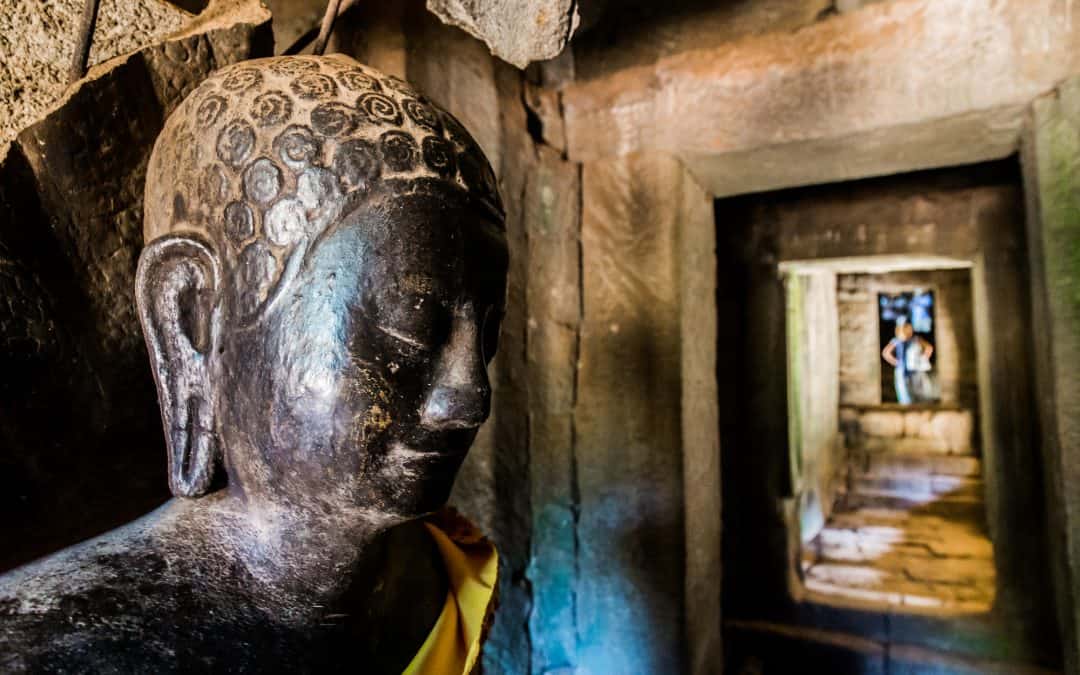Angkor Wat is the largest religious monument in the world, but it actually started out Hindu.
Back in the day, the Khmer Empire ruled this region of Southeast Asia and Hinduism was the main religion.
Angkor Wat was originally built as a Hindu temple to honor the god Vishnu. The carvings, architecture, and rituals all reflected Hindu beliefs.
Over time though, Buddhism spread across Southeast Asia and became the dominant religion in places like Cambodia. Around the 9th century, Angkor Wat started transitioning to Buddhism.
The carvings and iconography changed to include Buddha images and stupas.
This blending of Hindu and Buddhist symbols shows how the religious landscape was evolving.
Gradually, Angkor Wat fully embraced Buddhism, transforming into the Buddhist temple complex we see today.
The legacy of Buddhism had an enormous cultural impact that shaped Cambodian society for centuries to come.
Let’s dive in and trace the fascinating religious journey of Angkor Wat…
Key Takeaways
- Angkor Wat had strong Hindu origins and was originally built as a Hindu temple dedicated to the god Vishnu.
- Buddhism arrived in Southeast Asia and gradually influenced Angkor Wat, leading to the incorporation of Buddhist stupas and images of the Buddha alongside Hindu deities.
- The transition from Hinduism to Buddhism is reflected in the architectural changes of Angkor Wat, with Hindu deities being gradually replaced by Buddhist iconography.
- The spread of Buddhism in Cambodia can be traced back to the 5th century CE, but the exact timing of Angkor Wat’s embrace of Buddhism is unclear, suggesting a gradual shift over several centuries.
Pre-Buddhist Era: Hindu Origins of Angkor Wat
During the pre-Buddhist era, you’ll discover that Angkor Wat had strong Hindu origins.
Hindu rituals and religious practices were deeply ingrained in the culture of the Khmer Empire, which ruled over the region from the 9th to 15th centuries.
Angkor Wat, the largest religious monument in the world, was originally built as a Hindu temple dedicated to the god Vishnu.
The architectural design of Angkor Wat reflects the Hindu cosmology, with its five towers symbolizing the peaks of Mount Meru, the mythical abode of the gods.
The intricate carvings and bas-reliefs found throughout the temple complex depict scenes from Hindu mythology, showcasing the importance of Hinduism in the religious and cultural life of the Khmer people.
The Hindu rituals performed at Angkor Wat included elaborate ceremonies, offerings, and processions conducted by priests and devotees.
These rituals were meant to honor the deities and seek their blessings for the well-being and prosperity of the Khmer Empire.
The temple served as a sacred space where the Khmer kings and their subjects could connect with the divine and seek spiritual guidance.
The presence of Hindu rituals and religious practices at Angkor Wat highlights the significance of Hinduism in the pre-Buddhist era.
It laid the foundation for the later transition to Buddhism, which would become the dominant religion in the region.
Cultural Influences: The Arrival of Buddhism in Southeast Asia
After the pre-Buddhist era, the cultural influences at Angkor Wat shifted with the arrival of Buddhism in Southeast Asia.
This significant event marked a period of cultural assimilation and religious syncretism in the region.
The adoption of Buddhism by the Khmer Empire, which ruled over Angkor Wat, had a profound impact on the architecture, art, and religious practices of the temple complex.
Cultural assimilation occurred as the Khmer Empire embraced Buddhism and incorporated it into their existing Hindu-based traditions.
The influence of Buddhism can be seen in the architectural designs of Angkor Wat, with the addition of Buddhist stupas and images of the Buddha alongside Hindu deities.
This blending of religious motifs is a testament to the syncretism that took place during this time.
Religious syncretism refers to the merging of different religious beliefs and practices. As Buddhism spread throughout Southeast Asia, it encountered various local beliefs and customs, resulting in a unique blend of religious traditions.
This syncretism is evident in the religious rituals and ceremonies practiced at Angkor Wat, which incorporate elements from both Hinduism and Buddhism.
The arrival of Buddhism in Southeast Asia brought about a cultural transformation at Angkor Wat.
Through cultural assimilation and religious syncretism, the temple complex became a testament to the rich and diverse heritage of the region.
The blending of Hindu and Buddhist elements in the architecture and religious practices of Angkor Wat exemplifies the complex interplay of different cultures and beliefs in Southeast Asia.
Architectural Transformations: Signs of Buddhist Transition at Angkor Wat
As you explore Angkor Wat, you’ll notice the architectural transformations that signify the transition to Buddhism.
These changes can be observed through the religious symbolism incorporated into the design of the temple complex.
One of the most prominent architectural changes is the transition from Hindu deities to Buddhist iconography.
Hindu temples typically feature numerous carvings of gods and goddesses, while Buddhist temples focus more on the teachings of the Buddha.
At Angkor Wat, you’ll see the gradual replacement of Hindu deities with Buddhist figures such as the Buddha himself, bodhisattvas, and other important Buddhist symbols.
Another architectural change is the inclusion of Buddhist stupas within the temple complex. Stupas are structures that house relics or serve as a place of meditation and worship.
These stupas are often adorned with intricate carvings and serve as important religious symbols for Buddhists.
At Angkor Wat, you’ll find stupas incorporated into the temple architecture, indicating the shift towards Buddhism.
The architectural changes at Angkor Wat reflect the religious transformation that took place in the region.
Through the incorporation of Buddhist iconography and the inclusion of stupas, the temple complex signifies the transition from Hinduism to Buddhism.
These architectural transformations serve as tangible evidence of the changing religious landscape in Southeast Asia during the Angkor period.
Historical Evidence: When Did Angkor Wat Embrace Buddhism
To determine the timing of Angkor Wat’s embrace of Buddhism, examine the historical evidence available.
The spread of Buddhism in Cambodia can be traced back to the 5th century CE, when it began to gain popularity among the ruling elites.
However, it’s unclear when exactly Angkor Wat, the largest religious monument in the world, fully embraced Buddhism.
The historical evidence suggests that the transition occurred gradually over several centuries.
One piece of evidence is the inscription on a stone stele found at Angkor Wat, which dates back to the 9th century.
The inscription mentions the construction of a temple dedicated to the Hindu god Vishnu, indicating that Angkor Wat was originally built as a Hindu temple.
However, over time, there’s evidence of Buddhist influence on Angkor Wat.
For example, statues of the Buddha were added to the temple complex, and inscriptions mentioning Buddhist rituals and practices have been found.
Another important piece of evidence is the presence of Buddhist iconography in the bas-reliefs of Angkor Wat.
These intricate carvings depict scenes from Hindu mythology, but also include images of Buddhist deities, such as the Bodhisattva Avalokiteshvara.
This suggests that Buddhism was already a significant part of the religious landscape during the construction of Angkor Wat.
Legacy of Buddhism: Impact on Angkor Wat and Cambodian Culture
The legacy of Buddhism had a profound impact on both Angkor Wat and Cambodian culture.
The influence of Buddhism can be seen in the art and architecture of Angkor Wat, as well as in the religious practices of the Cambodian people.
One of the most notable impacts of Buddhism on Angkor Wat is evident in its intricate carvings and sculptures.
Buddhist motifs, such as lotus flowers, Bodhisattvas, and scenes from the life of the Buddha, are prominently featured throughout the temple complex.
These artistic expressions not only serve as religious symbols but also demonstrate the skill and craftsmanship of the Khmer people.
Religious practices in Cambodia were greatly influenced by the introduction of Buddhism.
The teachings of the Buddha, emphasizing compassion, mindfulness, and the pursuit of enlightenment, became central to the spiritual beliefs of the Cambodian people.
Buddhist monks played a crucial role in preserving and disseminating these teachings, and monastic communities were established throughout the country.
The impact of Buddhism on Cambodian culture extends beyond the religious sphere.
Buddhist principles, such as the emphasis on harmony and respect for all beings, have shaped the social fabric of Cambodian society.
These values can be seen in the strong sense of community and the importance placed on family and collective well-being.
Conclusion
So there you have it – the fascinating story of how Angkor Wat transitioned from Hinduism to Buddhism.
This remarkable temple has a rich history that gives us insight into the shifting religious landscape in Southeast Asia over the centuries.
While its Hindu origins are clear, the exact timing of Angkor Wat’s full embrace of Buddhism remains uncertain.
The evidence suggests it was a gradual process that took place over several hundred years, with Buddhism slowly gaining prominence through cultural assimilation and syncretism.
Tracing this religious evolution through the art, architecture and inscriptions of Angkor Wat reveals the enduring legacy of Buddhism on Cambodian society.
The temple stands today as a testament to this cultural transformation that shaped not just a monument, but an entire civilization.



